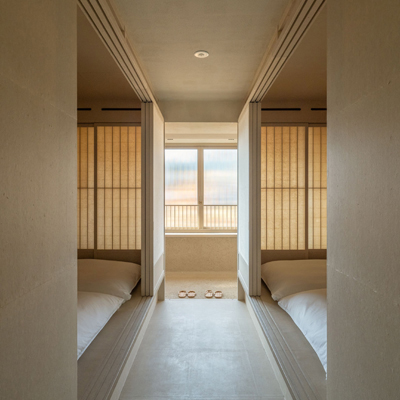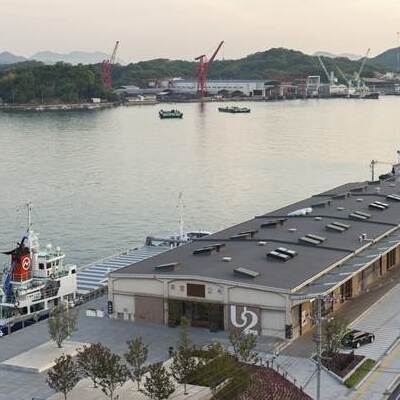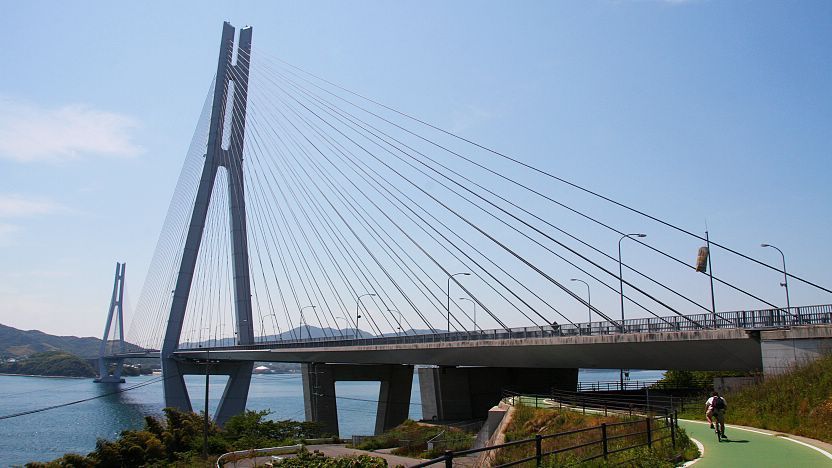
The Shimanami Kaido (éĄé▄é╚é▌ŖCō╣, Shimanami Kaidō) is a 60 kilometer long toll road that connects Japan's main island of Honshu to the island of Shikoku, passing over six small islands in the Seto Inland Sea. It is also known as the Nishiseto Expressway. There are two other land connections between Shikoku and Honshu, but the Shimanami Kaido is the only one traversable by foot or bicycle.
The Shimanami Kaido begins on Honshu in Onomichi City. It then leads across the six islands of Mukaishima, Innoshima, Ikuchijima, Omishima, Hakatajima and Oshima, before terminating on Shikoku in Imabari City. The route was opened in 1999, so the bridges are modern and attractive. Along the way, travelers can enjoy the beautiful scenery of the Seto Inland Sea and the islands' small towns.
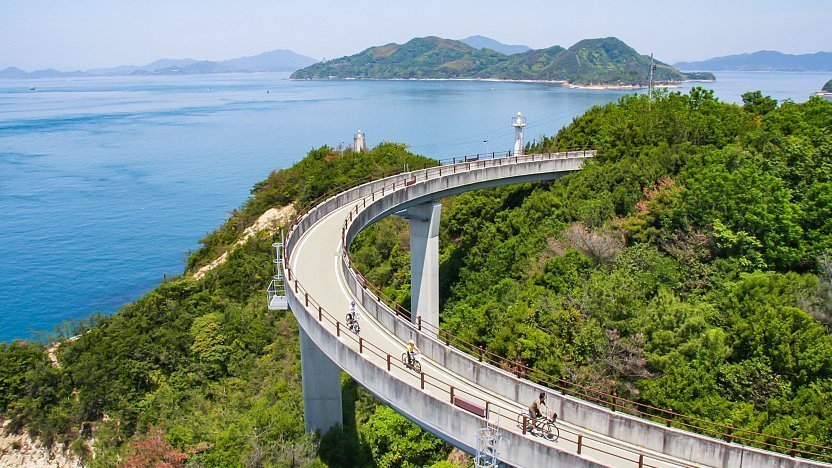
In addition to the scenery, there are a few other attractions on the way between Honshu and Shikoku: On Ikuchijima Island there is the Hirayama Museum, which is dedicated to one of Japan's most famous painters, Hirayama Ikuo, who was born there. Nearby is a unique temple, Kosanji, which was built by a rich businessman. There are a number of minshuku and camping grounds on the islands for those who want to extend the journey over multiple days.
Cycling is a popular means of experiencing the Shimanami Kaido. The bicycle route is well marked and maintained, and diverges from the expressway on the islands. The ramps leading up to the bridges were built at small inclines with cyclists in mind. At about 70 kilometers, the bike route is a bit longer than the toll road, but because there are no large inclines, it can be comfortably completed in a day by intermediate cyclists.
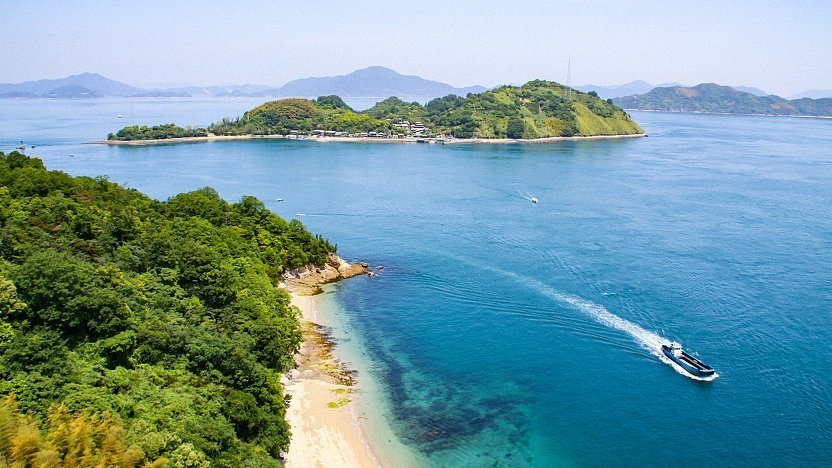
Two separate bicycle rental systems are offered along the Shimanami Kaido: the regular rental system features around ten terminals dotted along the cycling course, while a newer one is operated by bicycle manufacturer Giant with two terminals. Both systems allow tourists to rent their bicycles at one end of the route and drop it off at the other end, or - in case of the regular system - to stop at a terminal in between and take a bus for the rest of their journey.
The regular rental system is cheaper and offers more terminals. Various types of bicycles are available, but some of the smaller terminals have only a limited selection. The fee is 3,000 yen per day for regular bikes, 4000 yen for electric-assist bicycles and tendems, and 8000 yen for e-bikes. It is possible to drop off bicycles at different terminals except tandems, which must be returned to the same terminal. Reservations can be made online but are not mandatory.
The Giant rental system is more expensive and has only two terminals: one at Imabari Station and the other at Onomichi Station. Various high-quality bicycles are available for 4,000 to 17,000 yen per day. Drop-off at the other terminal is only possible with road bicycles, requires prior reservation and costs an additional 3,300 yen. Advance reservations can be made online.
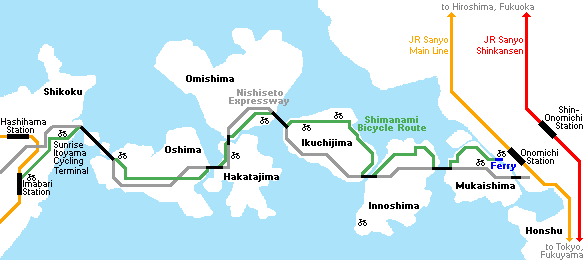
Small tolls (totaling around 500 yen) must be paid when crossing the bridges, not including the bridge between Honshu and Mukaishima Island, which is best replaced by a short ferry ride to/from central Onomichi (110 yen one way for an adult with bicycle). Note that until March 31, 2026, the tolls are waived for cyclists as a temporary measure to promote tourism. A same-day delivery service for luggage is available through Sagawa Express between selected hotels in Imabari and Onomichi.
Traveling the Shimanami Kaido is, of course, also possible by car. Expressway tolls total around 5000 yen one way. There are direct buses from Imabari to Hiroshima, Onomichi and Fukuyama.
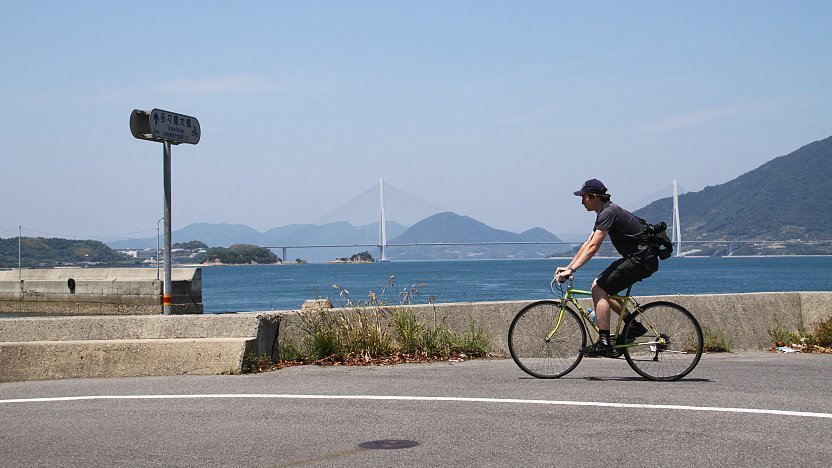
Getting there and around
Cycling Terminals
In Onomichi, the two cycling terminals are located about 150 meters from Onomichi Station. One is in a parking lot west of the Green Hill Hotel at the waterfront and the other, the Giant Onomichi store, is located in Onomichi U2, a redeveloped warehouse hotel beside this parking lot. There are three ferries operating between central Onomichi and Mukaishima, the starting point of the bicycle trail.
In Imabari, the two cycling terminals are located at Imabari Station. The terminal of the regular system is located a few steps from the station's west exit along the railway tracks, while the Giant Imabari store is located inside the station complex. Another large terminal is Sunrise Itoyama which also serves as a lodging; however, it is a bit difficult to access. There are infrequent buses from Imabari Station to the Sunrise Itoyama terminal. Alternatively, it is about a 2500 yen taxi ride from Imabari Station, or a 30 minute walk from Hashihama Station. For those who make reservations beforehand, a shuttle bus ride can be arranged.
Bus transportation along the Shimanami Kaido
Highway buses run from Imabari Station to Fukuyama (1.5 hours, 2800 yen, 1 bus/hour) and Hiroshima (3 hours, 4200 yen, 3-6 buses/day), while local bus lines connect Onomichi Station via Innoshima Ohashi bus stop to Habu Port on Innoshima (hourly buses) and Ikuchijima (one bus every 2-5 hours) where buses stop at Kosanji Temple and end at Setoda Port.
In order to travel by bus from Onomichi to Imabari, take a local bus from Onomichi Station to Innoshima Ohashi bus stop (25 minutes) and transfer to a highway bus to Imabari Station (55 minutes). Depending on connection times, the entire trip takes 1.5 to 2 hours and costs 2390 yen. There are hourly connections.
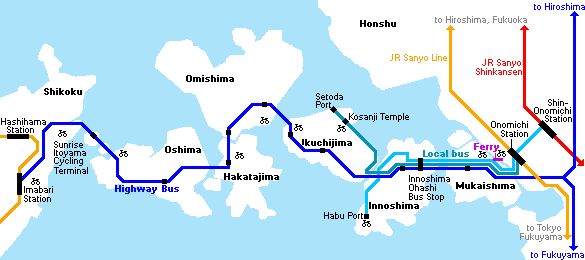
Ferry transportation along the Shimanami Kaido
There are many ferry lines that travel to and from the islands along the Shimanami Kaido. The following two lines are most relevant to foreign tourists:
- Onomichi Ekimae Port - Shigei Higashi Port - Sawa Port - Setoda Port:
40 minutes, 1500 yen (plus 500 yen for bicycle), departures every 1-2 hours
The Hirayama Museum and Kosanji Temple are located near both Setoda Port and Sawa Port. There are cycling terminals near all ports except for Shigei Higashi. Only one boat per day stops at Sawa Port. - Imabari Port - Tomoura Port - Kinoura Port - Habu Port:
75 minutes, 1780 yen, 4 departures per day
There is a cycling terminal near Habu Port. The line is served by a high speed ferry. Bicycles cannot be taken on board of some of the ferries.
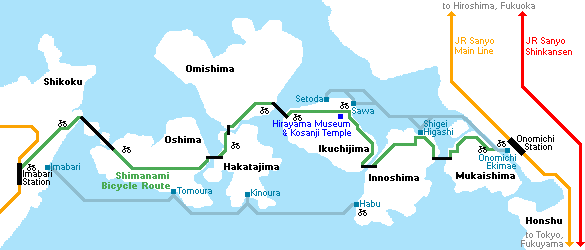
Questions? Ask in our forum.
Links and Resources
English
Hotels around Onomichi
-
-
![]() SponsoredOnomichi Hillside Complex, LOGDesigned by Indian architect Bijoy Jain of Studio Mumbai. This hotel was renovated from an apartment building built in 1963 and has a cafe & bar, a dining room, and shops.View siteSponsored
SponsoredOnomichi Hillside Complex, LOGDesigned by Indian architect Bijoy Jain of Studio Mumbai. This hotel was renovated from an apartment building built in 1963 and has a cafe & bar, a dining room, and shops.View siteSponsored -
![]() SponsoredONOMICHI U2 / HOTEL CYCLEA relaxing hotel renovated from a shipping warehouse. Start here for Shimanami Kaido cycling!View siteSponsored
SponsoredONOMICHI U2 / HOTEL CYCLEA relaxing hotel renovated from a shipping warehouse. Start here for Shimanami Kaido cycling!View siteSponsored
-
